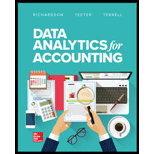
Data Analytics For Accounting
19th Edition
ISBN: 9781260375190
Author: RICHARDSON, Vernon J., Teeter, Ryan, Terrell, Katie
Publisher: Mcgraw-hill Education,
expand_more
expand_more
format_list_bulleted
Textbook Question
Chapter 1, Problem 7P
Consider the 2013 declined loan data from LendingClub titled “RejectStatsB2013.” Similar to the analysis done in the chapter, let’s scrub the employment length. Because our analysis requires risk scores, debt-to-income data, and employment length, we need to make sure each of them has valid data.
- a. Sort the file based on employment length and remove those observations (the complete row or record) that have a missing score (“NA”) or a score of zero.
- b. Sort the file based on debt-to-income and remove those observations (the complete row or record) that have a missing score, a score of zero, or a negative score.
- c. Sort the file based on risk score and remove those observations (the complete row or record) that have a missing score or a score of zero.
- d. There should now be 669,993 observations. Any thoughts on what biases are imposed when we remove observations? Is there another way to do this?
- e. Run a PivotTable analysis to show the number of Excellent Risk Scores but High DTI Bucket loans in each Employment year bucket. Any interpretation of why these loans were declined based on employment length?
Expert Solution & Answer
Want to see the full answer?
Check out a sample textbook solution
Students have asked these similar questions
Write a paragraph on each of the following topics: liquidity, asset management, debt management and profitability. Be sure to label these separately. Analyze each topic using the answers from your ratios to support your analysis by deciphering what they are telling you. Create a text box (Insert Menu, click on the “Text” button on the right side of the menu bar, and choose, “Text box”. Then click and drag a box to write in.
I can't get the titles correct for the Income Statement. THe ehlp I need is "yellow" highlighted. I have included all supporting data; Journal, Trial Balance. Can you explain what I should look for in the titles? What dictates what goes where? I try to look at other exercises to make correlations an get confused when they don't work.
Find the following values, using the equations, and then work the problems using a financial calculator to check your answers. Disregard rounding differences. (Hint: If you are using a financial calculator, you can enter the known values and then press the appropriate key to find the unknown variable. Then, without clearing the TVM register, you can "override" the variable that changes by simply entering a new value for it and then pressing the key for the unknown variable to obtain the second answer. This procedure can be used in parts b and d, and in many other situations, to see how changes in input variables affect the output variable.) Do not round intermediate calculations. Round your answers to the nearest cent.
An initial $800 compounded for 1 year at 6.5%.
$
An initial $800 compounded for 2 years at 6.5%.
$
The present value of $800 due in 1 year at a discount rate of 6.5%.
$
The present value of $800 due in 2 years at a discount rate of 6.5%
Chapter 1 Solutions
Data Analytics For Accounting
Ch. 1 - Prob. 1MCQCh. 1 - Prob. 2MCQCh. 1 - Prob. 3MCQCh. 1 - Prob. 4MCQCh. 1 - Prob. 5MCQCh. 1 - Prob. 6MCQCh. 1 - Prob. 7MCQCh. 1 - Prob. 8MCQCh. 1 - Prob. 9MCQCh. 1 - Prob. 10MCQ
Ch. 1 - Prob. 1DQCh. 1 - Give an example of how Data Analytics creates...Ch. 1 - Prob. 3DQCh. 1 - Prob. 4DQCh. 1 - Prob. 5DQCh. 1 - Prob. 6DQCh. 1 - Prob. 7DQCh. 1 - Prob. 8DQCh. 1 - Prob. 9DQCh. 1 - Prob. 10DQCh. 1 - Prob. 11DQCh. 1 - Prob. 12DQCh. 1 - To address the question Will I receive a loan from...Ch. 1 - Download and consider the data dictionary file...Ch. 1 - Download and consider the rejected loans dataset...Ch. 1 - Prob. 3PCh. 1 - Prob. 4PCh. 1 - Consider the 2013 declined loan data from...Ch. 1 - Consider the 2013 declined loan data from...
Knowledge Booster
Learn more about
Need a deep-dive on the concept behind this application? Look no further. Learn more about this topic, accounting and related others by exploring similar questions and additional content below.Similar questions
- I need help with question 6 on how to create the customer pivot table as given. Also, can you provide the steps of how to do that in Excel? Also, please provide the steps in order to solve the problem for Finance.arrow_forwardUsing Excel, create a table that shows the relationship between the interestearned and the amount deposited, as shown. we will first create the dollar amount column and the interest row, as shown . Next we will type into cell B3 the formula = $A3*B$2. We can now use the Fill command to copy the formula in other cells, resulting in the table as shown. Note that the dollar sign before A3 means column A is to remain unchanged in the calculations when the formula is copied into other cells. Also note that the dollar sign before 2 means that row 2 is to remain unchanged in calculations when the Fill command is used.arrow_forwardYou do not have to start from scratch, but note, these are completely independent pro formas. They must update accordingly from the data worksheets. Plan on showing your analysis and discussing the proforma changes that occur under each new scenario and how it affects profitability. Use a formatted text box (not a comment) to explain your recommendations under each new pro forma. This will be approximately a 2-3 paragraph endeavor. Scenario One: “What if” Analysis for adding flavored ice coffees. Your client is unsure if she should sell flavored ice coffees. She thinks she can sell a coffee to every second customer and it seems to be lucrative because the coffee sells for $3.75 each and costs him only $1.60 to purchase. Unfortunately your client is afraid that he would cannibalize his soft drink sales with the coffee customers (one soft drink less for every coffee sold). It will cost him $5,250 to purchase the equipment and insurance costs would rise by another…arrow_forward
- Give typing answer with explanation and conclusion What exactly is the DCR and how to lenders use it? Is there is a range they would find acceptable? In general, do they want it to be high or low? Why is that?arrow_forwardHello, I have categorized each item on this list as variable and fixed already. I have also did the journal entries. I need some assistance with the t-accounts and the balance sheet for this problem.arrow_forwardClick the Chart sheet tab. This chart is based on the problem data and the two income statements. Answer the following questions about the chart: a. What is the title for the X-axis? b. What is the title for the Y-axis? c. What does data range A represent? d. What does data range B represent? e. Why do the two data ranges cross? f. What would be a good title for this chart? When the assignment is complete, close the file without saving it again. Worksheet. The VARCOST2 worksheet is capable of calculating variable and absorption income when unit sales are equal to or less than production. An equally common situation (that this worksheet cannot handle) is when beginning inventory is present and sales volume exceeds production volume. Revise the worksheet Data Section to include: Also, change actual production to 70,000. Revise the Answer Section to accommodate this new data. Assume that Anderjak uses the weighted-average costing method for inventory. Preview the printout to make sure that the worksheet will print neatly on one page, and then print the worksheet. Save the completed file as VARCOSTT. Check figure: Absorption income, 670,000. Chart. Using the VARCOST2 file, fix up the chart used in requirement 5 by adding appropriate titles and legends and formatting the X- and Y-axes. Enter your name somewhere on the chart. Save the file again as VARCOST2. Print the chart.arrow_forward
- Respond to the following in a minimum of 175 words: Explain why proponents of LIFO argue that is provides a better match of revenue and expenses. In what situation would it not provide a better match?arrow_forwardChoose only one answer as well as state their reasons/rationale for the answer chosen. 5) Testing whether or not all employees are being paid at least the minimum wage would be an example of a(n):a. Reasonableness testb. Sign checkc. Check digit verificationd. Limit checkarrow_forwardWhat is the range of possible credit scores. Give examples of bad, average, excellent credit scores.arrow_forward
- Fill in the missing information on the paystub below, Remember you do non have to complete any YD calculations:arrow_forwardPlease model the following decision in a spreadsheet, optimize it using MS-Excel Solver, and then upload that spreadsheet by attaching it to this question. I will grade this question on the accuracy of your () spreadsheet model (decision variables, objective, and constraints), (i) Solver parameters, (i optimal solution. Partial credit is available. The personnel-planning problem of Lexington Bank. The main branch of Lexington Bank is open for retail business from 8:00 AM to 4:00 PM on weekdays. The staffing requires from 8 to 15 tellers on duty depending on the time of day, as indicated in the following table. Time Period Minimum No. of Tellers 8:00 AM - 10:00 AM 10:00 AM - 12:00 PM 12:00 PM - 2:00 PM 10 15 2:00 PM - 4:00 PM 12 Full-time tellers work 8 consecutive hours (from 8:00 AM to 4:00 PM) at $15 per hour. Part-time workers work 4 consecutive hours at $8 per hour starting at 8:00 AM, 10:00 AM, or 12:00 noon. Assume workers never take breaks. Union regulations require that all…arrow_forwardI need help to do question 9 from A to D and please include the formulas on how to solve using Excel and the answer for the Finance homework.arrow_forward
arrow_back_ios
SEE MORE QUESTIONS
arrow_forward_ios
Recommended textbooks for you
 Excel Applications for Accounting PrinciplesAccountingISBN:9781111581565Author:Gaylord N. SmithPublisher:Cengage Learning
Excel Applications for Accounting PrinciplesAccountingISBN:9781111581565Author:Gaylord N. SmithPublisher:Cengage Learning EBK CONTEMPORARY FINANCIAL MANAGEMENTFinanceISBN:9781337514835Author:MOYERPublisher:CENGAGE LEARNING - CONSIGNMENTPrinciples of Accounting Volume 2AccountingISBN:9781947172609Author:OpenStaxPublisher:OpenStax College
EBK CONTEMPORARY FINANCIAL MANAGEMENTFinanceISBN:9781337514835Author:MOYERPublisher:CENGAGE LEARNING - CONSIGNMENTPrinciples of Accounting Volume 2AccountingISBN:9781947172609Author:OpenStaxPublisher:OpenStax College Pkg Acc Infor Systems MS VISIO CDFinanceISBN:9781133935940Author:Ulric J. GelinasPublisher:CENGAGE L
Pkg Acc Infor Systems MS VISIO CDFinanceISBN:9781133935940Author:Ulric J. GelinasPublisher:CENGAGE L Financial Reporting, Financial Statement Analysis...FinanceISBN:9781285190907Author:James M. Wahlen, Stephen P. Baginski, Mark BradshawPublisher:Cengage Learning
Financial Reporting, Financial Statement Analysis...FinanceISBN:9781285190907Author:James M. Wahlen, Stephen P. Baginski, Mark BradshawPublisher:Cengage Learning

Excel Applications for Accounting Principles
Accounting
ISBN:9781111581565
Author:Gaylord N. Smith
Publisher:Cengage Learning

EBK CONTEMPORARY FINANCIAL MANAGEMENT
Finance
ISBN:9781337514835
Author:MOYER
Publisher:CENGAGE LEARNING - CONSIGNMENT

Principles of Accounting Volume 2
Accounting
ISBN:9781947172609
Author:OpenStax
Publisher:OpenStax College

Pkg Acc Infor Systems MS VISIO CD
Finance
ISBN:9781133935940
Author:Ulric J. Gelinas
Publisher:CENGAGE L

Financial Reporting, Financial Statement Analysis...
Finance
ISBN:9781285190907
Author:James M. Wahlen, Stephen P. Baginski, Mark Bradshaw
Publisher:Cengage Learning
What is Risk Management? | Risk Management process; Author: Educationleaves;https://www.youtube.com/watch?v=IP-E75FGFkU;License: Standard youtube license